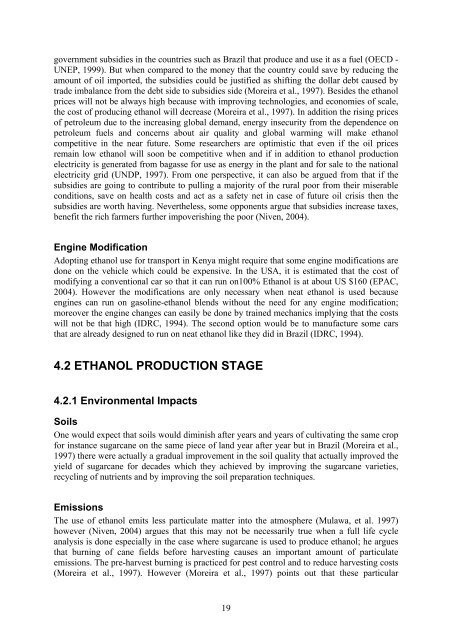ethanol fuel production and use in kenya for sustainable ... - lumes
ethanol fuel production and use in kenya for sustainable ... - lumes
ethanol fuel production and use in kenya for sustainable ... - lumes
You also want an ePaper? Increase the reach of your titles
YUMPU automatically turns print PDFs into web optimized ePapers that Google loves.
government subsidies <strong>in</strong> the countries such as Brazil that produce <strong>and</strong> <strong>use</strong> it as a <strong>fuel</strong> (OECD -UNEP, 1999). But when compared to the money that the country could save by reduc<strong>in</strong>g theamount of oil imported, the subsidies could be justified as shift<strong>in</strong>g the dollar debt ca<strong>use</strong>d bytrade imbalance from the debt side to subsidies side (Moreira et al., 1997). Besides the <strong>ethanol</strong>prices will not be always high beca<strong>use</strong> with improv<strong>in</strong>g technologies, <strong>and</strong> economies of scale,the cost of produc<strong>in</strong>g <strong>ethanol</strong> will decrease (Moreira et al., 1997). In addition the ris<strong>in</strong>g pricesof petroleum due to the <strong>in</strong>creas<strong>in</strong>g global dem<strong>and</strong>, energy <strong>in</strong>security from the dependence onpetroleum <strong>fuel</strong>s <strong>and</strong> concerns about air quality <strong>and</strong> global warm<strong>in</strong>g will make <strong>ethanol</strong>competitive <strong>in</strong> the near future. Some researchers are optimistic that even if the oil pricesrema<strong>in</strong> low <strong>ethanol</strong> will soon be competitive when <strong>and</strong> if <strong>in</strong> addition to <strong>ethanol</strong> <strong>production</strong>electricity is generated from bagasse <strong>for</strong> <strong>use</strong> as energy <strong>in</strong> the plant <strong>and</strong> <strong>for</strong> sale to the nationalelectricity grid (UNDP, 1997). From one perspective, it can also be argued from that if thesubsidies are go<strong>in</strong>g to contribute to pull<strong>in</strong>g a majority of the rural poor from their miserableconditions, save on health costs <strong>and</strong> act as a safety net <strong>in</strong> case of future oil crisis then thesubsidies are worth hav<strong>in</strong>g. Nevertheless, some opponents argue that subsidies <strong>in</strong>crease taxes,benefit the rich farmers further impoverish<strong>in</strong>g the poor (Niven, 2004).Eng<strong>in</strong>e ModificationAdopt<strong>in</strong>g <strong>ethanol</strong> <strong>use</strong> <strong>for</strong> transport <strong>in</strong> Kenya might require that some eng<strong>in</strong>e modifications aredone on the vehicle which could be expensive. In the USA, it is estimated that the cost ofmodify<strong>in</strong>g a conventional car so that it can run on100% Ethanol is at about US $160 (EPAC,2004). However the modifications are only necessary when neat <strong>ethanol</strong> is <strong>use</strong>d beca<strong>use</strong>eng<strong>in</strong>es can run on gasol<strong>in</strong>e-<strong>ethanol</strong> blends without the need <strong>for</strong> any eng<strong>in</strong>e modification;moreover the eng<strong>in</strong>e changes can easily be done by tra<strong>in</strong>ed mechanics imply<strong>in</strong>g that the costswill not be that high (IDRC, 1994). The second option would be to manufacture some carsthat are already designed to run on neat <strong>ethanol</strong> like they did <strong>in</strong> Brazil (IDRC, 1994).4.2 ETHANOL PRODUCTION STAGE4.2.1 Environmental ImpactsSoilsOne would expect that soils would dim<strong>in</strong>ish after years <strong>and</strong> years of cultivat<strong>in</strong>g the same crop<strong>for</strong> <strong>in</strong>stance sugarcane on the same piece of l<strong>and</strong> year after year but <strong>in</strong> Brazil (Moreira et al.,1997) there were actually a gradual improvement <strong>in</strong> the soil quality that actually improved theyield of sugarcane <strong>for</strong> decades which they achieved by improv<strong>in</strong>g the sugarcane varieties,recycl<strong>in</strong>g of nutrients <strong>and</strong> by improv<strong>in</strong>g the soil preparation techniques.EmissionsThe <strong>use</strong> of <strong>ethanol</strong> emits less particulate matter <strong>in</strong>to the atmosphere (Mulawa, et al. 1997)however (Niven, 2004) argues that this may not be necessarily true when a full life cycleanalysis is done especially <strong>in</strong> the case where sugarcane is <strong>use</strong>d to produce <strong>ethanol</strong>; he arguesthat burn<strong>in</strong>g of cane fields be<strong>for</strong>e harvest<strong>in</strong>g ca<strong>use</strong>s an important amount of particulateemissions. The pre-harvest burn<strong>in</strong>g is practiced <strong>for</strong> pest control <strong>and</strong> to reduce harvest<strong>in</strong>g costs(Moreira et al., 1997). However (Moreira et al., 1997) po<strong>in</strong>ts out that these particular19
















